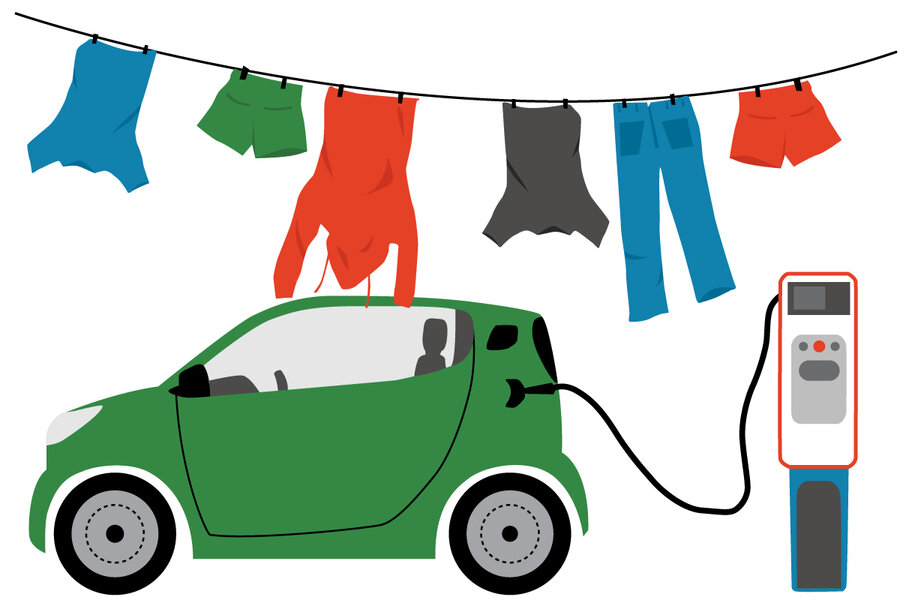We asked, you answered: How do you go green?
Individual action is one part of the global equation to stopping climate change. Here are some of the ways in which Monitor readers "go green."
Meat consumption
We have traveled to Japan several times, and something we noticed about the food there is that it has meat, but probably only about one-third of what we normally would have eaten in a meal. However, while we were there, we didn’t miss the other two-thirds, because the meat was mixed in with lots of other tasty vegetables and sauces.
This has changed our eating habits. Before, when eating meat, we would each have had a big piece of steak – but now, if we cut up just half the amount of steak and mix it into a rice or noodle stir-fry, we don’t feel we are eating less.
Andrew Smith
Brisbane, Australia
Lifelong decisions
We have continued trying to live simply, as we have for the 56 years of our marriage. We reuse what we can, including our home, which is a formerly abandoned farmhouse that we’ve fixed up. We’ve never had a clothes dryer; we hang our laundry outside in summer and in the basement in winter. We adopted our second child, thereby not adding to world population. We grow much of our own food. We limit our driving and try to consolidate our errands for fewer trips to town. (There is no public transportation where we live.)
When we waste electricity, I picture the coal-burning power plants that created it. Awareness of climate change has only increased the efforts we’ve made to live lightly on the land.
Judy and Mike White
Ashland, Oregon
Solar panels
As a child of depression-era parents, I’ve always been a conservationist. About two years ago, I installed solar panels in a zoned area that doesn’t allow people to go “off grid.” Now, once a year, I receive a check for the amount of energy my system has produced (less the amount I’ve used).
Rather than being more free with my energy consumption, I’ve become aware of how much I use – and look for ways to cut it. For example, I’ve installed switches on the plugs of always-on appliances – anything that emits light when not in use (e.g., the printer, microwave, and coffee pot). To stop these slow leak usages, it’s easy to press the switch off rather than unplug the devices in awkward locations.
Laura Berkelman
Melrose, Florida
Building carefully
My house is single story and about 1,600 square feet. I chose it because two-story homes are less efficient to cool (hot air rises in them, forcing excessive use of air conditioning for space that is unused for most of the day). Years ago, I also installed ceiling fans, as well as double-pane windows. This makes the house cooler and quieter.
In my yard, I eliminated the front lawn. Instead, I planted drought-resistant shrubs and heavily mulched the ground with redwood bark. Less lawn equals less lawnmower use. Plus, lizards, snakes, toads, and frogs love it. They act as a natural pest control, which means I have fewer insect problems.
Gordon Jones
Gridley, California
Car choices
Our main contribution toward “going green” is driving an electric car for probably 90% of our local trips. We leased a two-seater Smart car for three years, and then bought a 2019 Chevrolet Bolt EV. (We kept our 17-year-old Subaru for snow.) Our Bolt gets the equivalent of up to 128 mpg and is a blast to drive. I’m still figuring out all the bells and whistles.
Brad Knickerbocker
Ashland, Oregon
[Editor’s note: Mr. Knickerbocker is a former Monitor staff writer and editor.]
Biking to work
I teach an AP environmental science course, and my students see my wife and me almost every day – not just in school, but walking or riding bicycles around town. This allows us to set an example for our students of what life can look like if we make decisions that are consistent with our principles.
Howard Tenenbaum
San Diego
Discussion
We in Australia are also concerned about climate change. For me, it’s been helpful to understand the idea of removing the dialogue of “who is right or wrong.” Instead, we just need to face up to the problems we are experiencing and then decide how we can individually help our planet regain its harmonious balance.
Lorraine Mahon
Geelong, Australia






